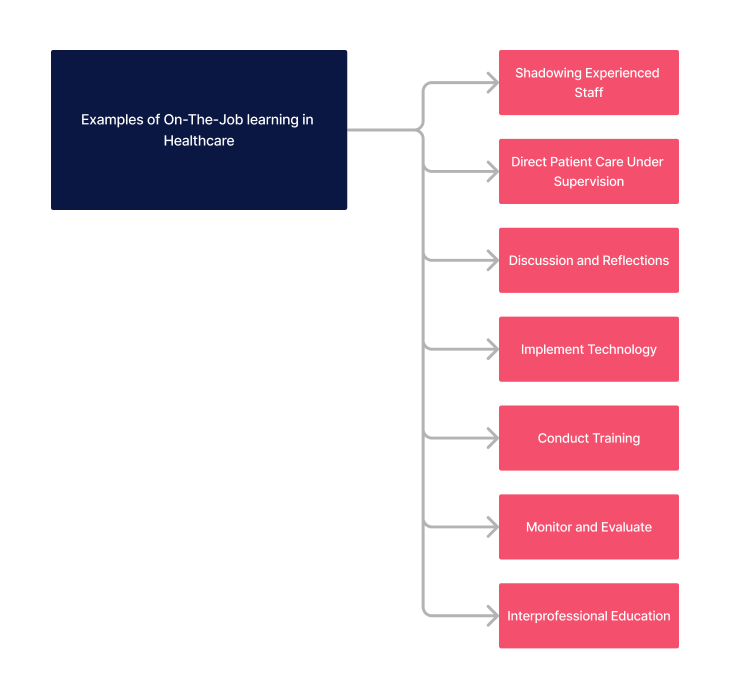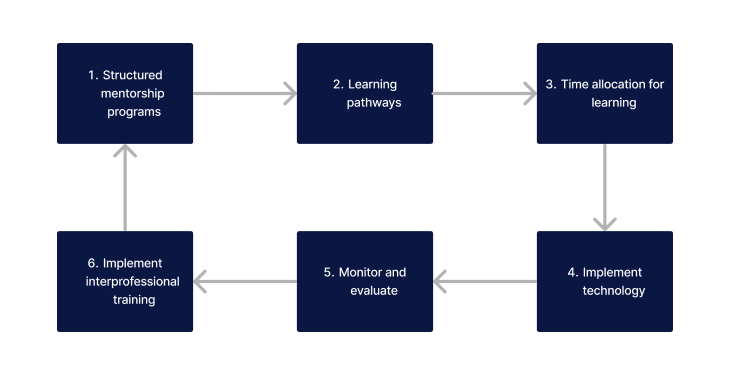What is On the Job Learning in Healthcare?
On-the-job learning is a dynamic and immersive training method wherein health professionals and medical specialists acquire new skills and knowledge directly within their working environment. Unlike traditional educational settings that often rely on theoretical instruction and simulated scenarios, on the job is inherently hands-on and grounded in the realities of day-to-day healthcare operations. This approach enables learners to apply theoretical knowledge in real-life contexts, offering a deeper understanding and retention of critical skills necessary for high-quality patient care.
Examples of On-The-Job learning in healthcare

On-the-job learning in healthcare encompasses a variety of formats, each designed to enhance the practical skills and knowledge of health professionals within their specific work environment. This method of learning is critical for ensuring that healthcare employees are not only well-trained in theoretical knowledge but are also adept at applying this knowledge in real-world situations, thereby enhancing the quality of patient care.
Below are some detailed examples of on-the-job learning in healthcare:
- Shadowing Experienced Staff: This allows learners to gain insights into clinical practices, communication skills, and the nuances of patient care that are difficult to teach in a classroom setting.
- Direct Patient Care Under Supervision: Health professionals performing their duties directly with patients but under the close supervision of a mentor or supervisor. This approach allows for immediate feedback and guidance.
- Discussion and Reflections: Real time reflective practices on the decisions made and their outcomes. This method enhances critical thinking and clinical judgment skills.
- Implement Technology: Utilise a robust learning management system (LMS) to facilitate online aspects of the training, including content delivery, communication, and progress tracking.
- Conduct Training: Execute the blended learning program, ensuring a seamless integration of online and traditional elements. Provide ongoing support to learners throughout the training period.
- Monitor and Evaluate: Performance assessments can be formal or informal and are used to evaluate the learner's application of new skills and knowledge in their work environment.
- Interprofessional Education: professionals from various healthcare disciplines learn together and from each other, can enhance practical skills related to teamwork, communication, and collaborative patient care.
What’s the Difference Between On-the-Job Learning and Training?
While on-the-job learning is immersive and occurs within the actual work setting, traditional training often takes place in a more controlled environment, such as classrooms or online modules. The former emphasises hands-on experience and immediate application, whereas the latter may focus more on theoretical knowledge and may not always reflect the complexities of real-life healthcare scenarios.
What is the Role of On-the-Job Learning in Healthcare?
On-the-job learning plays a crucial role in the healthcare sector by providing health professionals with the opportunity to learn new skills and refine existing ones in a real-world context. This learning process is vital for adapting to the rapidly changing healthcare environment and for the delivery of high-quality health services.
Positives and Negatives of On The Job Learning
The table below provides a comparative overview of the benefits and negatives associated with on-the-job learning in healthcare. It highlights the dual-edged nature of on-the-job, showcasing how, while it offers immediate and impactful learning opportunities that enhance patient care and professional development, it also presents challenges such as inconsistencies in learning experiences and demands on senior staff's time.
| Positives | Negatives |
|---|---|
| Immediate applicability of skills in real-world scenarios enhances the quality of patient care. | Potential inconsistency in learning experiences due to variability in mentors' teaching abilities and patient cases. |
| Enhanced learning motivation through hands-on experience and direct contribution to patient outcomes. | Significant time investment required from senior staff for mentoring, which could strain resources. |
| Fosters a culture of continuous improvement and teamwork among healthcare professionals. | Limited scope for learning in specialised areas without access to diverse patient cases or advanced technologies. |
| Continuous adaptation to new technologies and healthcare practices, keeping professionals current and competent. | Risk of learning in high-pressure situations, which may lead to stress and burnout among learners. |
How to Improve On-The- Job Learning in Healthcare

Improving on-the-job learning in healthcare involves a strategic approach to enhance the effectiveness and efficiency of learning experiences for health professionals. Here are a few strategies, each with a brief description, to achieve this:
- Structured Mentorship Programs: This structured approach ensures consistent, high-quality learning experiences.
- Learning Pathways: This clarity helps learners focus on critical skills and knowledge areas, enhancing the relevance.
- Time Allocation for Learning: This recognition of learning as a critical component of their role can improve engagement and reduce the pressure of balancing work and development needs.
- Implement Technology: Utilise a robust learning management system (LMS) to facilitate online aspects of the training, including content delivery, communication, and progress tracking.
- Monitor and Evaluate: Performance assessments can be formal or informal and are used to evaluate the learner's application of new skills and knowledge in their work environment.
- Implement Interprofessional Education: Healthcare professionals from various healthcare disciplines learn together and from each other, can enhance practical skills related to teamwork, communication, and collaborative patient care.
Tips for Implementing On-the-job Learning
On-the-job learning program hinges on planning, the right mix of learning methods, and the use of technology to facilitate learning and track progress. Establishing clear objectives at the outset provides a roadmap for both learners and instructors, ensuring that every aspect of the on-the-job experience is purposeful and targeted towards enhancing patient care and professional development.
- Define Clear Objectives
- Choose a mix of online and face-to-face elements that complement each other.
- Invest in a robust learning management system for efficient content delivery and progress tracking.
- Regularly update content to reflect the latest healthcare practices and research.
- Select the Right Trainers
- Encourage collaboration and interaction among learners to build a community of practice.
- Integrate real-world case studies and scenarios to enhance practical understanding.
- Ensure accessibility and ease of use for all technology and materials used.
Related Resources
- LMS in Healthcare: The Roles, Benefits and Pros and Cons
- A Guide to Self-Directed Learning
- How to Create a Culture of Continuous Learning
- How to Manage an Effective Staff Training Program
- Identifying Skills Gaps with Learning Analytics
- A Guide to Personalised Learning in Healthcare
Conclusion
The role of on-the-job learning in healthcare extends beyond skill acquisition; it is fundamental in adapting to the rapidly evolving healthcare landscape, enhancing patient care and safety, and supporting professional development and career progression. Furthermore, it cultivates a culture of excellence, collaboration, and innovation within healthcare organisations, ensuring a responsive and effective health system capable of meeting the changing needs of its population. In essence, on-the-job learning is an indispensable tool in the continuous pursuit of excellence in healthcare, embodying the dynamic interplay between learning and practical application in the quest to meet and surpass the standards of patient care and professional development.
References
- Akdere, M, and Egan, T, 2020. Transformational leadership and human resource development: Linking employee learning, job satisfaction, and organizational performance. Human Resource Development Quarterly, vol.31, no.4, pp.393-421, https://doi.org/10.1002/hrdq.21404.
- Costar, DM, and Hall, KK, 2020. Improving team performance and patient safety on the job through team training and performance support tools: A systematic review. Journal of patient safety, vol. 16, no.3, p.S48. doi: 10.1097/PTS.0000000000000746
- Butt, A.S., Shamim, MS, Ali, MA, Qamar, F, Khan, IQ, Tariq, S, Hashmi, SA, Hafeez, Q, Tariq, M, Shamim, S and Hafeez, QUA, 2021. Applying a mixed-method approach to improve on-the-job learning and job satisfaction in a cohort of interns at a university hospital, vol.3, no. 6.
- O’sullivan, B, Hickson, H, Kippen, R, Cohen, D, Cohen, P and Wallace, G, 2021, A framework to guide the implementation of best practice clinical learning environments in community general practice: Australia, International Journal of Environmental Research and Public Health, vol. 18, no. 4, p.1482.
- Hookmani, AA, Lalani, N, Sultan, N, Zubairi, A, Hussain, A, Hasan, BS and Rasheed, MA., 2021. Development of an on-job mentorship programme to improve nursing experience for enhanced patient experience of compassionate care, BMC nursing, vol.20, pp.1-1



